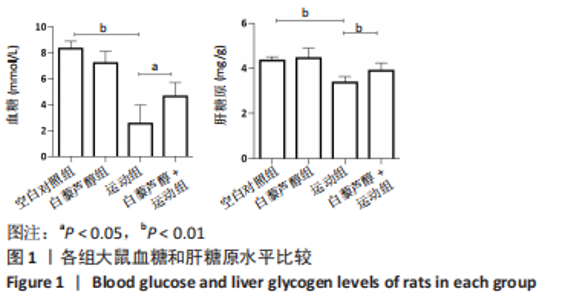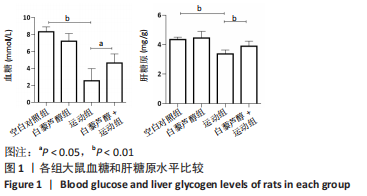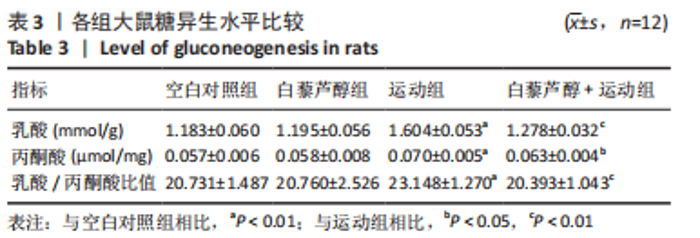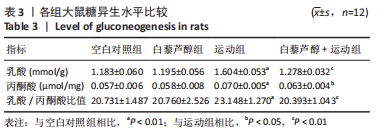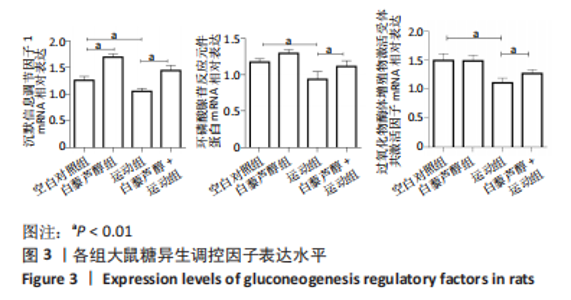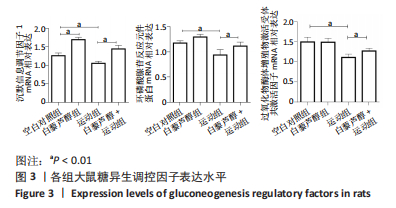Chinese Journal of Tissue Engineering Research ›› 2024, Vol. 28 ›› Issue (8): 1229-1234.doi: 10.12307/2023.960
Previous Articles Next Articles
Effect of resveratrol on gluconeogenesis in exercise-induced fatigue rats
Ruan Rong1, Lou Xujia2, Jin Qiguan1, Zhang Libing1, Xu Shang1, Hu Yulong1
- 1School of Physical Education, Yangzhou University, Yangzhou 225021, Jiangsu Province, China; 2Zhengzhou Sports Vocational College, Dengfeng 452470, Henan Province, China
-
Received:2022-10-17Accepted:2022-12-29Online:2024-03-18Published:2023-07-18 -
Contact:Hu Yulong, MD, Associate professor, School of Physical Education, Yangzhou University, Yangzhou 225021, Jiangsu Province, China -
About author:Ruan Rong, Master candidate, School of Physical Education, Yangzhou University, Yangzhou 225021, Jiangsu Province, China -
Supported by:2016 National Key Research and Development Program of China, No. 2016YFD0400603-02 (to JQG)
CLC Number:
Cite this article
Ruan Rong, Lou Xujia, Jin Qiguan, Zhang Libing, Xu Shang, Hu Yulong. Effect of resveratrol on gluconeogenesis in exercise-induced fatigue rats[J]. Chinese Journal of Tissue Engineering Research, 2024, 28(8): 1229-1234.
share this article
Add to citation manager EndNote|Reference Manager|ProCite|BibTeX|RefWorks
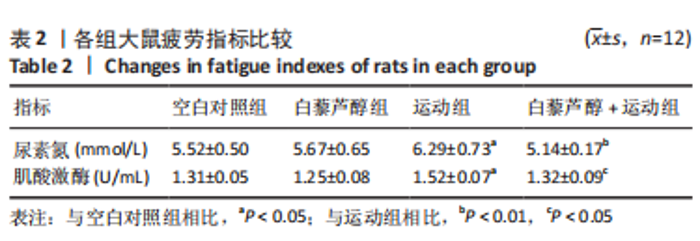
2.1 实验动物数量分析 实验选用SD大鼠共48只,分为4组,每组12只,实验过程无脱失,全部进入结果分析。 2.2 大鼠基本情况观察 大鼠运动45-50 min时频繁出现下沉甚至跳出水面的情况,此时捞出休息30 s以免大鼠死亡,运动结束后运动组大鼠出现反应迟钝、双眼无光、皮毛蓬乱、运动能力下降等现象,表明大鼠已达到疲劳状态;白藜芦醇+运动组出现下沉甚至跳出水面的情况相对较少。 2.3 白藜芦醇对运动性疲劳相关指标的影响 与空白对照组相比,运动组血浆中尿素氮和肌酸激酶水平均明显升高(均P < 0.05),提示长时间中高强度运动造成大鼠疲劳,蛋白质分解加强,伴随肌肉组织损伤。与运动组相比,白藜芦醇+运动组血浆中尿素氮和肌酸激酶水平显著降低(P < 0.01,P < 0.05),提示白藜芦醇减缓了大鼠肌肉蛋白质的过度分解,肌肉组织损伤得到改善,对运动性疲劳大鼠产生了保护作用。见表2。"
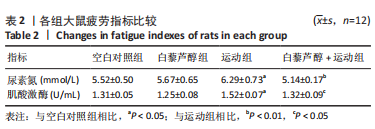
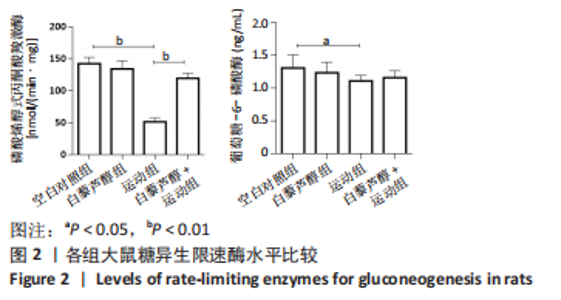
2.5 白藜芦醇对运动性疲劳大鼠糖异生限速酶活性的影响 PEPCK和G6Pase是糖异生途径的两个关键限速酶,是衡量糖异生水平的重要分子标志物。与空白对照组相比,运动组糖异生限速酶PEPCK和G6Pase的活性显著降低(P < 0.01,P < 0.05),提示长时间中高强度运动对PEPCK和G6Pase的活性有抑制作用,使肝脏合成葡萄糖的能力下降,糖原输出减少。与运动组相比,补充白藜芦醇使白藜芦醇+运动组的PEPCK活性显著提高(P < 0.01),G6Pase活性略有升高,但差异无显著性意义(P > 0.05),提示白藜芦醇能提高糖异生限速酶的活性,促进糖异生活动,增加糖原输出。见图2。"
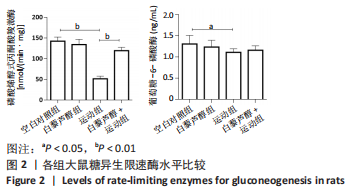
| [1] 田野. 运动生理学高级教程[M].北京:高等教育出版社,2003: 453-470. [2] 张蕴琨,丁树哲. 运动生物化学[M].北京:高等教育出版社,2014: 145. [3] GONZALEZ JT, FUCHS CJ, BETTS JA, et al. Liver glycogen metabolism during and after prolonged endurance-type exercise. Am J Physiol Endocrinol Metab. 2016;311(3):E543-E553. [4] MULLER GY, MATOS FO, PEREGO JUNIOR JE, et al. High-intensity interval resistance training (HIIRT) improves liver gluconeogenesis from lactate in Swiss mice. Appl Physiol Nutr Metab. 2022;47(4):439-446. [5] CHOI I, RICKERT E, FERNANDEZ M, et al. SIRT1 in Astrocytes Regulates Glucose Metabolism and Reproductive Function. Endocrinology. 2019; 160(6):1547-1560. [6] SHE Y, SUN J, HOU P, et al. Time-restricted feeding attenuates gluconeogenic activity through inhibition of PGC-1α expression and activity. Physiol Behav. 2021;231:113313. [7] 李先宽,李赫宇,李帅,等. 白藜芦醇研究进展[J]. 中草药,2016, 47(14):2568-2578. [8] 杨海荣,李雪斌,劳贞贤,等. 白藜芦醇药理作用研究进展[J]. 中国老年学杂志, 2020,40(16):3572-3575. [9] 郭瑞. 白藜芦醇抗疲劳作用及其机理研究[J]. 食品研究与开发, 2018,39(24):174-179. [10] TUNG YT, WU MF, LEE MC, et al. Antifatigue Activity and Exercise Performance of Phenolic-Rich Extracts from Calendula officinalis, Ribes nigrum, and Vaccinium myrtillus. Nutrients. 2019;11(8):1715. [11] HUANG WC, HSU YJ, WEI L, et al. Association of physical performance and biochemical profile of mice with intrinsic endurance swimming. Int J Med Sci. 2016;13(12):892-901. [12] XIE Y, Li Z, WANG Y, et al. Effects of moderate-versus high-intensity swimming training on inflammatory and CD4(+) T cell subset profiles in experimental autoimmune encephalomyelitis mice. J Neuroimmunol. 2019;328:60-67. [13] 贾瑞真,姜超,金其贯,等. 左旋肉碱、泛酸、辅酶Q_(10)联合干预有氧运动疲劳模型小鼠的作用及机制[J]. 中国组织工程研究, 2022,26(2):165-170. [14] 李方,曹建民,翟鹏飞,等. 白藜芦醇调节NLRP3炎性小体改善力竭运动大鼠肾组织炎症损伤[J]. 陆军军医大学学报,2022,44(12): 1229-1236. [15] 代朋乙,黄昌林. 运动性疲劳研究进展[J]. 解放军医学杂志,2016, 41(11):955-964. [16] ZHANG X, YANG S, CHEN J, et al. Unraveling the Regulation of Hepatic Gluconeogenesis. Front Endocrinol (Lausanne). 2019;9:802. [17] LEE MC, HSU YJ, LIN YQ, et al. Effects of Perch Essence Supplementation on Improving Exercise Performance and Anti-Fatigue in Mice. Int J Environ Res Public Health. 2022;19(3):1155. [18] GIURIATO G, VENTURELLI M, MATIAS A, et al. Capsaicin and Its Effect on Exercise Performance, Fatigue and Inflammation after Exercise. Nutrients. 2022;14(2):232. [19] 赵静. 运动疲劳机制及食源性抗疲劳活性成分研究进展[J]. 食品安全质量检测学报,2021,12(9):3565-3571. [20] QIN LL, LU TF, QIN Y, et al. In Vivo Effect of Resveratrol-Loaded Solid Lipid Nanoparticles to Relieve Physical Fatigue for Sports Nutrition Supplements. Molecules. 2020;25(22):5302. [21] LÓPEZ-SOLDADO I, GUINOVART JJ, DURAN J. Increased liver glycogen levels enhance exercise capacity in mice. J Biol Chem. 2021;297(2): 100976. [22] BALTACI AK, DURAN MO, MOGULKOC R, et al. Resveratrol does not affect leptin while it has regulatory effects on liver glycogen levels in exercised and non-exercised rats. Int J Vitam Nutr Res. 2019;89(5-6): 303-308. [23] 熊正英,张琳,武胜奇.白藜芦醇对大强度耐力训练大鼠部分生化指标的影响[J]. 武汉体育学院学报,2008,42(8):62-66. [24] 浦钧宗, WASSERMAN K, WHIPP BJ,等.对常人运动中达无氧阈时动脉血乳酸、丙酮酸等指标变化的探讨[J]. 中国运动医学杂志, 1985(1):17-23+63. [25] 沈文清,张强,张怡,等.不同方式急性运动结合二甲双胍改善 2型糖尿病小鼠血糖稳态及肝脏糖异生的作用[J]. 首都体育学院学报,2019,31(6):560-569. [26] 韩锦铂,王一国. 肝脏糖异生的调控[J].中国细胞生物学学报, 2019,41(7):1216-1224. [27] RAJAS F, GAUTIER-STEIN A, MITHIEUX G. Glucose-6 Phosphate, A Central Hub for Liver Carbohydrate Metabolism. Metabolites. 2019; 9(12):282. [28] 陈娟娟. 人参果胶WGPA通过促进糖异生途径改善小鼠运动性疲劳的研究[D]. 长春:东北师范大学,2017. [29] HUANG JP, TAGAWA T, MA SH, et al. Black Ginger (Kaempferia parviflora) Extract Enhances Endurance Capacity by Improving Energy Metabolism and Substrate Utilization in Mice. Nutrients. 2022;14(18): 3845. [30] KOMINE S, MIYAZAKI T, ISHIKURA K, et al. Taurine supplementation enhances endurance capacity by delaying blood glucose decline during prolonged exercise in rats. Amino Acids. 2022;54(2):251-260. [31] ZHANG WW, XUE R, MI TY, et al. Propofol ameliorates acute postoperative fatigue and promotes glucagon-regulated hepatic gluconeogenesis by activating CREB/PGC-1α and accelerating fatty acids beta-oxidation. Biochem Biophys Res Commun. 2022;586: 121-128. [32] RODGERS JT, LERIN C, HAAS W. et al. Nutrient control of glucose homeostasis through a complex of PGC-1α and SIRT1. Nature. 2005; 434:113-118. [33] WANG T, WANG Y, LIU L, et al. Research progress on sirtuins family members and cell senescence. Eur J Med Chem. 2020;193:112207. [34] RODGERS JT, PUIGSERVER P. Fasting-dependent glucose and lipid metabolic response through hepatic sirtuin 1. Proc Natl Acad Sci U S A. 2007;104(31):12861-12866. [35] PARK JM, KIM TH, BAE JS, et al. Role of resveratrol in FOXO1-mediated gluconeogenic gene expression in the liver. Biochem Biophys Res Commun. 2010;403(3-4):329-334. [36] WEI YJ, WANG JF, CHENG F, et al. miR-124-3p targeted SIRT1 to regulate cell apoptosis, inflammatory response, and oxidative stress in acute myocardial infarction in rats via modulation of the FGF21/CREB/PGC1alpha pathway. J Physiol Biochem. 2021;77(4):577-587. [37] LI BX, GARDNER R, XUE C, et al. Systemic Inhibition of CREB is Well-tolerated in vivo. Sci Rep. 2016;6(1):34513. [38] THIEL G, ROSSLER OG. Resveratrol stimulates cyclic AMP response element mediated gene transcription. Mol Nutr Food Res. 2016;60(2): 256-265. [39] 吴遵桃.生命早期铅致SD大鼠学习记忆损伤及白藜芦醇的保护作用[D].郑州:郑州大学,2020. [40] 乔爱君,左瑾,刘晓军,等. Sirt1基因的研究进展[J]. 中国医学科学院学报,2009,31(6):782-785. [41] HERZIG S, LONG FX, JHALA US, et al. CREB regulates hepatic gluconeogenesis through the coactivator PGC-1. Nature. 2001;413 (6852):179-183. [42] 韩向晖,季光.肝脏糖异生的分子机制研究进展[J]. 世界华人消化杂志,2008,16(32):3659-3665. [43] 娄旭佳.白藜芦醇对运动性疲劳大鼠线粒体能量代谢的影响[D].扬州:扬州大学,2022. [44] HAASE TN, RINGHOLM S, LEICK L, et al. Role of PGC-1alpha in exercise and fasting-induced adaptations in mouse liver. Am J Physiol Regul Integr Comp Physiol. 2011;301(5):R1501-R1509. |
| [1] | Yue Yun, Wang Peipei, Yuan Zhaohe, He Shengcun, Jia Xusheng, Liu Qian, Li Zhantao, Fu Huiling, Song Fei, Jia Menghui. Effects of croton cream on JNK/p38 MAPK signaling pathway and neuronal apoptosis in cerebral ischemia-reperfusion injury rats [J]. Chinese Journal of Tissue Engineering Research, 2024, 28(8): 1186-1192. |
| [2] | Zhao Garida, Ren Yizhong, Han Changxu, Kong Lingyue, Jia Yanbo. Mechanism of Mongolian Medicine Erden-uril on osteoarthritis in rats [J]. Chinese Journal of Tissue Engineering Research, 2024, 28(8): 1193-1199. |
| [3] | Liu Xin, Hu Man, Zhao Wenjie, Zhang Yu, Meng Bo, Yang Sheng, Peng Qing, Zhang Liang, Wang Jingcheng. Cadmium promotes senescence of annulus fibrosus cells via activation of PI3K/Akt signaling pathway [J]. Chinese Journal of Tissue Engineering Research, 2024, 28(8): 1217-1222. |
| [4] | Zuo Xinwei, Liu Gang, Bai Huizhong, Xu Lin, Zhao Yi, Ren Jingpei, Hu Chuanyu, Mu Xiaohong. Relationship between lumbar spine development and hip development in children with spastic cerebral palsy [J]. Chinese Journal of Tissue Engineering Research, 2024, 28(8): 1247-1252. |
| [5] | Zhang Xihui, Li Zhengrong, Li Shineng, Xing Zengyu, Wang Jiao. Effect of rehabilitation training guided by Pro-kin balance system on proprioception and balance function of the affected knee after anterior cruciate ligament reconstruction [J]. Chinese Journal of Tissue Engineering Research, 2024, 28(8): 1259-1264. |
| [6] | Qi Xue, Li Jiahui, Zhu Yuanfeng, Yu Lu, Wang Peng. Abnormal modification of alpha-synuclein and its mechanism in Parkinson’s disease [J]. Chinese Journal of Tissue Engineering Research, 2024, 28(8): 1301-1306. |
| [7] | Kong Jianda, Mu Yujing, Zhu Lei, Li Zhilin, Chen Shijuan. Mechanism of satellite cell regulation and its role in ecological niche signaling during skeletal muscle regeneration [J]. Chinese Journal of Tissue Engineering Research, 2024, 28(7): 1105-1111. |
| [8] | Huang Yuxin, Liang Wenzi, Chen Xiuwen, Ni Na, Zhao Yinglin, Lin Changmin. Role of autophagy in hair regeneration [J]. Chinese Journal of Tissue Engineering Research, 2024, 28(7): 1112-1117. |
| [9] | Ma Shuwei, He Sheng, Han Bing, Zhang Liaoyun. Exosomes derived from mesenchymal stem cells in treatment of animals with acute liver failure: a meta-analysis [J]. Chinese Journal of Tissue Engineering Research, 2024, 28(7): 1137-1142. |
| [10] | Mei Jingyi, Liu Jiang, Xiao Cong, Liu Peng, Zhou Haohao, Lin Zhanyi. Proliferation and metabolic patterns of smooth muscle cells during construction of tissue-engineered blood vessels [J]. Chinese Journal of Tissue Engineering Research, 2024, 28(7): 1043-1049. |
| [11] | Tan Nengxian, Wu Wenzheng, Zheng Churong, Luo Lieliang, Gu Peng, Ouyang Chongzhi, Zheng Xiaohui. Finite element analysis of different fixation methods of partially threaded cannulated screws for treating vertical femoral neck fractures [J]. Chinese Journal of Tissue Engineering Research, 2024, 28(6): 873-878. |
| [12] | Chen Zan, Lei Fei, Ye Fei, Zhou Qingzhong, Yuan Hao, Zheng Lipeng, Zha Xian, Feng Daxiong. Relationship between drainage time and early efficacy after short-segment lumbar fusion [J]. Chinese Journal of Tissue Engineering Research, 2024, 28(6): 927-933. |
| [13] | Kaiyisaier•Abudukelimu, Maimaitimin•Abulimiti, Li Lei, Yang Xiaokai, Zhang Yukun, Liu Shuai. Effect of lumbar CT values in the diagnosis of osteoporosis in women patients with lumbar degenerative diseases [J]. Chinese Journal of Tissue Engineering Research, 2024, 28(6): 945-949. |
| [14] | Zhang Zeyi, Yang Yimin, Li Wenyan, Zhang Meizhen. Effect of foot progression angle on lower extremity kinetics of knee osteoarthritis patients of different ages: a systematic review and meta-analysis [J]. Chinese Journal of Tissue Engineering Research, 2024, 28(6): 968-975. |
| [15] | Jiang Zihao, Wang Guanglan, Chen Peng, Sun Xianghong, Wang Ting, Jia Shaohui, Zheng Cheng. Effect of eccentric training combined with different frequency whole body vibration training on patellar tendinopathy [J]. Chinese Journal of Tissue Engineering Research, 2024, 28(4): 493-498. |
| Viewed | ||||||
|
Full text |
|
|||||
|
Abstract |
|
|||||
